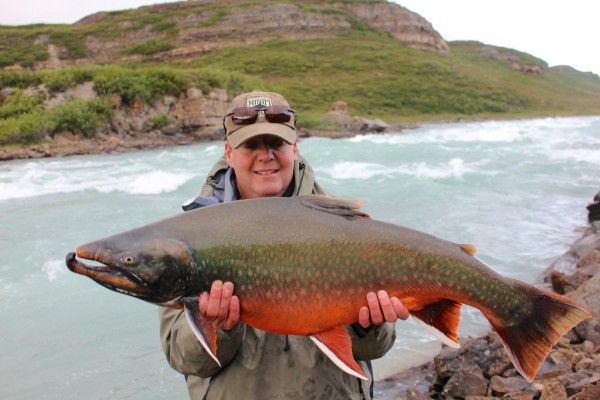
Mike's big char of the trip at over 26 LB.!
Click to view image
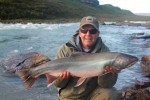
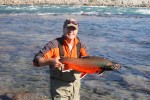

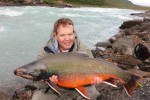
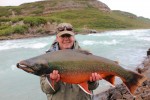
When considering all the trout and char species in the world, the arctic char is on the far end of the fishing spectrum. It is an extension of the extreme environment of the lake trout and exists at least as far north as its cousin. The arctic char primarily exists in the land where trees cannot even grow, where the summer sun lasts for days and in winter it disappears for weeks. These fish thrive north of the Arctic Circle, where they are prey to polar bears, seals, and Eskimos. Even though these fish live in such extreme cold conditions, where ice covers their waters 50-60 percent of the year, they do spend a considerable time in the ocean. It is in the ocean where the nutrient rich food is abundant and with their longevity, that these fish can reach trophy sizes.
The arctic char also shows one of the most significant anatomical transformations when it leaves the sea and enters the streams and lakes to spawn. When in the sea, it exhibits the silver sheen that is observed by other anadromous salmonoids, the sleek body and silver sides. When it ascends the freshwater to spawn, the male’s bellies turn a brilliant red as do their spots. Their backs turn a beautiful bluish green. Their heads transform to a prominent kype that is similar to an old brown trout. Their body thickens from top to bottom and thins from side to side. These features make it look similar to a giant spawning male brook trout and are one of the reasons the male arctic char is one of the most revered of all trophy fish.
It was back in 1998 when I visited Great Bear Lake for the first time and the Tree River char was the reason. It was only through Plummer’s Lodge, that controlled access to the Tree is still offered as a side trip from Great Bear Lake. The Tree continues to be well known for the world’s largest Arctic Char. The majority of world records come from this river and this includes the all tackle world record, a fish that eclipsed the 32-pound mark. The river is typically divided into two sections, the lower section being wider and boat-able. It has several deep holes where char will gather on their way upriver. The upper section of the river is very different. This section is rough and wild. It has numerous class 5 rapids and several treacherous waterfalls. The char make it up through the first two of three waterfalls, a feat that requires them to ascend a height of about 8 feet. The third waterfall is a monster that drops more than 30-feet, and is the barrier for these char. The upper river is also on a very steep gradient, of between 5 and 10 percent, making it one of the fastest flowing sections of river I have ever fished. This upper river is where the biggest char take hold in the fall and this presents many challenges to any fisherman.
The banks of the Tree are composed of fine bentonite sediments, a chalky soil that easily erodes. On my original trip to the Tree, a massive thunderstorm had taken place at the headwaters of this river, releasing tons of this soil into the river, turning the water to the color of a vanilla milkshake. Visibility was less than one inch! My timing could have not been worse, as this change happened about an hour after I arrived. The blown out river never cleared during that two day visit and only a few fish were landed by the entire fishing party. I vowed I would return some day, and that happened to be in August 2014. As I planned to fish this river, my biggest fear would be whether it would blow out again, as arctic weather is very unpredictable. Odds were in my favor, as arctic summers are relatively dry, but with the massive changing in the world’s weather patterns, who really knows what to expect weather wise, regardless of location.
In my pre-trip research, I decided I would focus on flyfishing to be my primary method, but would also pack a spinning rod and lures. I figured it would be good to change up if fishing slowed down or in case the conditions favored one technique over another. The pixie lure is the predominant lure for arctic char, with silver and pink being the most popular color. However, char are attracted to any of the fluorescent colors including orange and chartreuse. Lure weights were between 3/4 and 1oz. as they would need to sink fast to reach the bottom currents where the char reside. For flies, my focus was to reproduce the pixie colors, so most of my patters were silver with the fluorescent colors. I also included some very bright flies that were solid chartreuse or solid pink, patterns that might be more effective on a river that was highly turbid.
Another segment of my pre-trip research was to contact some of the river guides who hold considerable knowledge of the Tree River. Those guides provided some key points to remember. First, was to be ready for the high velocity of the Tree. This river flows fast and that requires that the flies and lures go down deep rather quickly. Second, the river is essentially covered with boulders and has relatively little sand. This means that snags are to be expected and that one should bring plenty of flies and lures. Last, was to be on the lookout for color changes due to weather. A small amount of rain was welcome, as slightly cloudy water triggers aggression from char versus clear water when the fish become much harder to catch. In fact, in pictures that I located of some of the biggest char I have been caught from the Tree, where caught when the water was slightly turbid or grey in color.
Our trip was scheduled to be for three days. All of those in our group wanted to fish for these char as late in the season as was possible, with hopes to catch one of the big red male char that exhibit the incredible brook trout-like brilliant colorations. We expected these red fish to be more difficult to catch, but felt it was worth the extra effort. In July, most of the char in the Tree River are silver and much more aggressive and easier to catch.
To get to the Tree, we flew from Yellowknife to Great Bear Lake Lodge where we spent the night. The next morning, the weather was acceptable to the bush pilot, so we boarded the turbo otter for the three hour flight over to the Tree River. We arrived on the river in the later afternoon, had some lunch, and readied our rods. The guides indicated that the water was getting more and more turbid, thus making the visibility decrease by the minute! We decided immediately to head out to the river, not knowing if the river was going to completely blow out or just slightly become more turbid.
Our group split up heading upstream from camp on both sides of the river. This late in the year, most of the char were in the upper part, which was the portion with the high velocity flows and torturous rapids. The water was getting more and more turbid, making pockets of water more difficult to detect. We finally got to the point where we had to guess where there might be good holding water for fish and then fish these areas with intense focus.
I had worked my way upriver for nearly two miles without any sightings of fish or any strikes. I tried both Pixie spoons and flies, continuously changing patterns that might finally attract that monster char. I was nearly up to what is known as the second waterfall, a 4-6 foot drop. The char typically pool up below this barrier, so we focused on this area. My buddy Jim hooked the first char of the trip in a tiny pocket of water behind a rock. The fish took a silver and chartreuse fly. As soon as that fish was released, he immediately hooked into a second fish that was slightly larger. Both fish were silver females that were 10 and 12 pounds respectively.
After helping photograph Jim’s char I moved up to the next pocket of water. To this point I had no luck, no strikes, no follows, nothing. I kept changing patterns and noticed the water continued to lose clarity. I finally selected the brightest pattern in my box, a solid chartreuse streamer. I made the first cast and had my first follow, a large fish with a large head, but it was such a fast follow, I could not gauge the size of the fish. I repeated the cast and what I presumed to be the same fish followed again but would not strike. Instead of pounding the water, I walked away from the tiny pocket to let it settle down. I fished a couple of pools upstream and then returned to the pocket, hopeful for a change in my luck.
I made my first cast into the pocket and allowed an extra couple of seconds for the fly to sink. This time a fish took the fly and the hookup was solid. The fish held its ground and never left the small pocket for the fast water below, only making several tight circles. After just a few minutes, the fish was lead into the net and my first Tree River char was landed.
The fish was a monster male char, showing all those characteristics that I had seen from other specimens from this same water. The male had the giant kype and the bright orange body, spots and fins. From back to belly the fish was incredibly deep, with a girth of 24 inches. From nose to tail, the fish taped out at 37inches. My dream of a trophy male arctic char was more than realized!
After taking more than a couple of dozen photos, the char was placed in the water to be released. I expected it to take some time for this fish to recover, but it burst free from my grip and disappeared back into the chalky waters of the Tree. This was the most revealing characteristic of these fish, their strength and endurance.
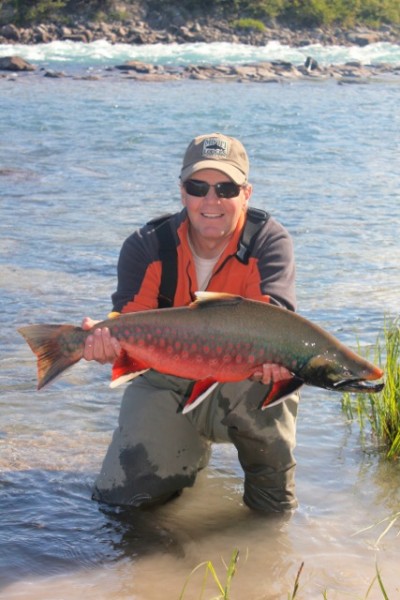
I would love to get into one of these big char!
Click to view image
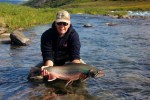
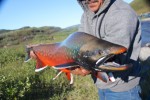
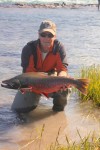
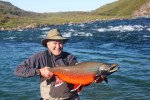
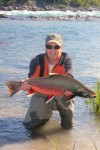
I moved to the next pool and promptly hooked another char, this time it was a nice female that weighed about 18 pounds. She was much fresher from the ocean, with a slender profile and lighter coloration. The fish took the same chartreuse streamer and once hooked, remained in the same pool. She showed no sign of wear from the battle as she violently released herself back into this river. That would prove to be my last fish of the day, but what a day to remember!
During night the river became significantly clearer, but by morning, it still had some turbidity. The visibility was between 4-5 feet and it allowed us to spot a few fish throughout the day. The morning was slow, but the afternoon picked up as I landed three more char that ranged between 10 and 15 pounds. These fish were all fresher fish, showing some color, but not exhibiting the same characteristics as those fish that had been in the river longer. The same chartreuse flies again produced all the fish.
The last two days arrived with brighter skies and the water became incredibly clear. The third morning was very productive and I landed several char that were absolutely beautiful. Each of these fish would have been a” trophy of a lifetime” as they also had the size to go along with their colors. These were all 10-20 pound char, which is what has made the Tree so famous. The last fish of the third day would prove to me my last arctic char of this trip, as the super clear water put the brakes on the fishing.
The trip proved to be most effective with my fly rod, which was an 8-weight rod with a 300 grain sink line. My tippet consisted of a short 12-inch butt section of 25 pound test followed by another 4 foot section of 15-pound line. This proved to be a good setup as I did lose many flies to the rocks. If the fly did not come loose, the 15-pound tippet would sever before breaking the fly line. As for flies, I never had success with any pattern other than those that contained chartreuse. Solid chartreuse with flash proved to work best, but flies that had white or silver also produced.
Spinning tackle was rigged using a 20-pound braid and about a 4-6 foot leader of 15-pound fluorocarbon. I stuck with Pixie lures for the entire trip, but only fished them about 10-percent of the time. However, others in our group did have their best success with these same lures, with silver and pink catching the most char. Rods with medium action seemed to be adequate to subdue these fish, though a few did run into the rapids. When they made this move, it was simply game over!
On average I lost between twenty and thirty flies a day, but the char were on the bottom and they would not come up for a fly or lure. The pockets were very tight in that one could not simply cast upstream and drift into a hole as this would result in a snag every time. The key was to fish a tight pocket and get the fly or lure down deep as soon as possible. Then when the cast was near the bottom of the pocket, it had to be reeled in before it would snag in the rocks. There were some spots that held huge char that were impossible to fish. For example, some trophy fish were found in 4-foot diameter holes that were five to six feet deep and bordered by huge rocks. Then, with a 10-12 knot current flowing over the hole, there was no possibility to get a fly or lure down to the fish. They had the perfect protection.
After waiting more than 15-years to return to the Tree, I found it to be well worth the wait. This time, I was better prepared, bringing dozens of flies and lures, knowing I would donate a serious portion of them to the bottom. I dreaded the thought of the river blowing out from another weather event, but this time, the turbidity of the water was found to be an advantage. The river provided camouflage for the fish, but also for us. This allowed us to approach pockets without spooking these fish. Bright patterns worked as they provided the best visibility to the fish and were consistent until the water cleared. If the water had been crystal clear for the four days, I am not sure we would have landed many fish at all.
I hope to return to this river again someday, as it is as beautiful a river as it is challenging. Photos do not do justice to the beauty and ruggedness of the river and the surrounding gorge through which it flows. And its chief inhabitants, the spawning male char certainly lived up to their reputation as being one of the most beautiful of fish in the world! Someday I will return, again!